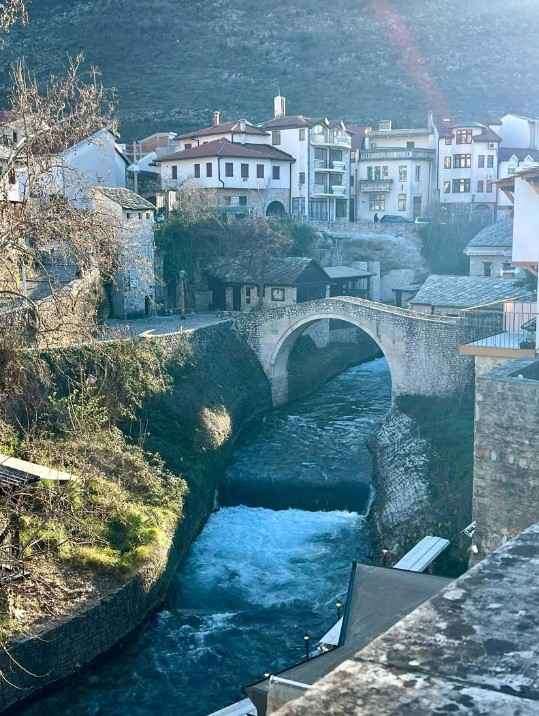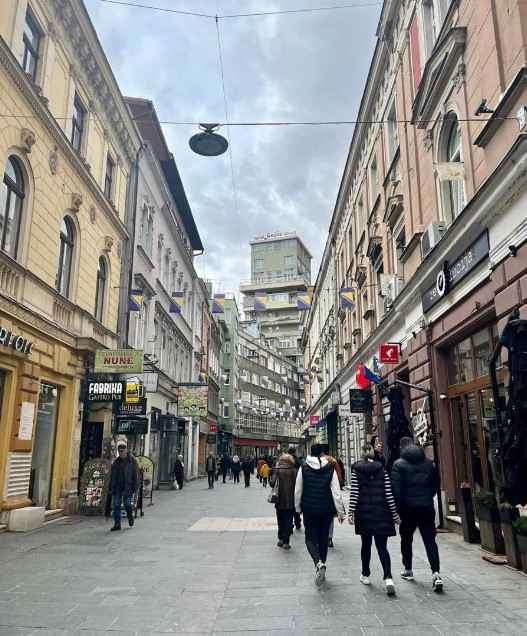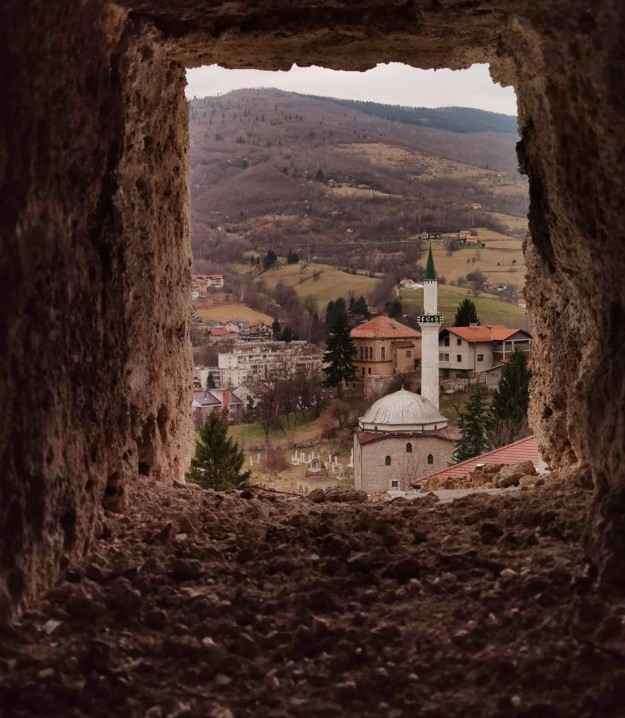- Home
- Blog
- Write for Us
- Travel Shop
- Type of TripsSolo Female TravelGirls Trip DestinationsAdventureBudget TravelLuxury TravelSolo Female TravelGirls Trip DestinationsAdventureBudget TravelLuxury Travel
- Resources

Table of Contents
Greetings, fellow travelers! We are about to begin a one-of-a-kind journey through Dark Tourism in Bosnia. With over five years of experience exploring these areas, we are excited to share the stories and secrets of places that have witnessed more than their fair share of history.
Sarajevo isn’t just another city on the map; it’s a living history book. The city’s famous ‘Sarajevo Roses’ – mortar scars filled with red resin – are moving tributes to those lost in the siege. The War Tunnel & Museum, once a vital escape route during tough times, symbolizes endurance. And let’s not forget the Museum of Crimes against Humanity and Genocide, a sobering reminder of the past’s harsh truths.

Strolling through Mostar, you’ll see the iconic Stari Most bridge. It’s a symbol of hope, rebuilt from the ruins of War. The city, with its visible war wounds, tells a tale of resilience and recovery.

In Srebrenica, silence speaks volumes. This site, known for the tragic genocide, is a melancholy spot that teaches us about the horrors of hatred. The Srebrenica-Potočari Memorial and Cemetery honors the innocent lives lost and stands as a powerful call for peace and understanding.
Imagine sleeping in a place that simulates War. Sarajevo’s War Hostel does just that. It’s a debate starter – some find it too intense. Still, for the owner, a war survivor, it’s about sharing personal survival tales. This kind of dark tourism can be tricky, balancing respect with the raw reality of War.
This Tunnel of Hope, once a secret path under siege, is now a museum. It’s a fascinating mix of a tourist spot and a history lesson, showing the lengths people will go to for survival.
In the picturesque town of Jajce, there’s more than just a stunning waterfall. This place is a history buff’s dream, packed with medieval landmarks and WWII history. It’s got a fortress, secret catacombs, and a museum where key WWII decisions were made. It’s like stepping back into a history book.
Underneath Konjic’s peaceful hills lies a Cold War secret: Tito’s Bunker. This massive underground hideout, built for Yugoslavia’s president, takes you back to a time when nuclear war fears were real. Now open for tours, it’s a must-see for anyone interested in Cold War history.
Mostar’s Sniper Tower, a former bank, tells a haunting story. During the War, snipers used it to control the city. Its graffiti-covered walls and bullet holes silently narrate the past’s darker chapters.
Travnik isn’t just pretty; it’s a town where culture and conflict intersect. With its Ottoman-era architecture, this town shows off Bosnia’s rich history and the marks left by recent conflicts. It’s a mix of serene beauty and sobering history.

In northeastern Bosnia, Bijeljina stands as a symbol of resilience. Once caught in the turmoil of War, the town now embodies peace. Places like the Tavna Monastery and the Atik mosque highlight Bosnia’s diverse cultural tapestry.
The War Childhood Museum in Sarajevo tells a unique story: children’s lives during the War. Through personal items and stories, it sheds light on how War impacts the innocent. It’s an eye-opening experience that tugs at the heartstrings.
Once a war casualty, the National Library in Sarajevo now shines anew. It’s not just a library; it’s a symbol of cultural revival. Rebuilt from ruins, it stands as a beacon of knowledge and resilience. A visit here connects you to Bosnia’s rich literary and cultural heritage.
Dark tourism in Bosnia isn’t just about the gloom. It helps the country heal and educates visitors about its history. It’s a way to remember the past while hoping for a brighter future. As you wander through these sites, you’ll find stories of resilience, struggle, and the unbreakable human spirit.
What Makes Bosnia a Popular Dark Tourism Destination?
Answer: Bosnia’s popularity in dark tourism is largely due to its recent history, particularly the Bosnian War of the 1990s. Sites like Sarajevo, Mostar, and Srebrenica are focal points because of their significant roles in the War. These places offer a stark reminder of the conflict and its impact on the nation.
How Do Locals in Bosnia View Dark Tourism?
Answer: The local perspective on dark tourism in Bosnia is complex. While some see it as an opportunity to educate tourists and share personal stories of the War, others view it as voyeurism. For instance, the Sarajevo War Hostel offers an immersive’ war experience,’ which some might find controversial. However, it is seen by the owner as a way to educate and share authentic experiences.
What Are the Key Dark Tourism Sites in Bosnia?
Answer: Key dark tourism sites in Bosnia include Sarajevo, with its War Tunnel & Museum, the assassination site of Archduke Franz Ferdinand, and the Museum of Crimes Against Humanity and Genocide. Other important sites are the city of Mostar and the Srebrenica-Potočari Memorial and Cemetery.
Is Dark Tourism Beneficial or Harmful to Bosnia?
Answer: Dark tourism in Bosnia can be both educational and controversial. On one hand, it helps the region’s economic recovery, providing a platform for locals to narrate their history. On the other hand, it raises ethical questions about the portrayal and commercialization of tragic events.
How Does Dark Tourism Influence the Perception of Bosnia?
Answer: Dark tourism can reinforce certain stereotypes or preconceived notions about Bosnia, especially its war-torn past. While it brings awareness to the country’s history, there’s a risk of oversimplifying or sensationalizing the complex realities of the War and its aftermath.
What Challenges Does Dark Tourism Present in Bosnia?
Answer: A significant challenge of dark tourism in Bosnia is balancing the need for historical education with the risk of trivializing or commodifying past tragedies. Sites like the Tunnel of Hope in Sarajevo navigate this fine line between being a tourist attraction and an educational site
Our journey through Bosnia’s dark tourism sites is more than just sightseeing. It’s a lesson in history, a reflection on the human condition, and a testament to the power of hope. With its scars and stories, Bosnia isn’t just a place to visit. It’s a place to learn, feel, and understand human resilience’s depth. But no matter which part of Bosnia you visit, always remember to Travel Till You Drop!


Hi, Jill Here
Hi! I’m Jill, a Dallas, Texas girl traveling the world. After a career in the Air Force and touring over 50 countries later, my need to explore keeps going! It’s time to rock & roll and find all those places I never knew I was missing.
Table of Contents
Join me to get exclusive travel tips, giveaways and more!
Gallery
Copyright © 2023 | All Right Reserved